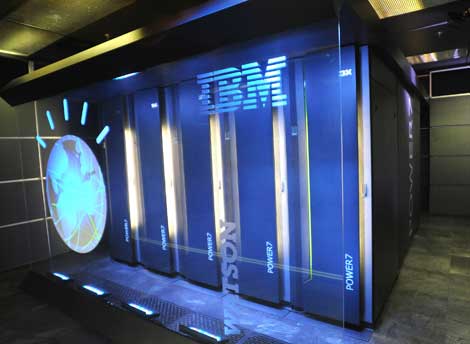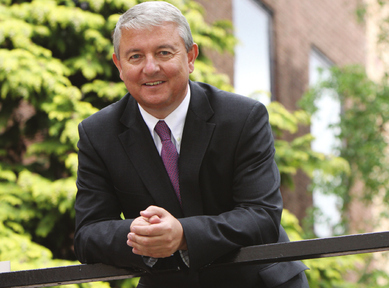IBM, or ‘Big Blue’ as it is known in the technology industry, is 100 years old today. The company was formed on 16 June 1911 in New York by Charles Ranlett Flint as the Computer-Tabulating-Recording Company.
It now employs more than 425,000 people worldwide, has revenues of close to $100bn and, according to Fortune magazine, is the seventh most profitable company in the US. It also holds more patents than any other US technology company.
IBM came to Ireland in 1956 with a room above the Shelbourne Hotel. Today, it employs 3,000 people across Ireland, with the majority based at a state-of-the-art campus in Blanchardstown.
Perhaps in a fitting tribute to how far IBM has come, IBM’s Watson Computer – named after one of its earliest leaders, Thomas J Watson, and which competed in and won in the quiz show Jeopardy! – was named as ‘Person of the Year’ at the influential 15th Annual Webby Awards this week.
How does a company get to 100?
So what is the secret sauce behind a technology company that has lasted the test of time – well, 100 years anyway?

IBM has an all-encompassing approach to technology, from servers, storage and cloud, to smarter cities and the environment. To get a sense of perspective, the company has curated 100 milestones that have shaped it and the world in the last century – from the technology driving the social security system in the US, to the invention of the floppy disk, the creation of the first corporate science research laboratory, and the establishment of the Corporate Service Corps (a corporate version of the Peace Corps). Rich content and unique visual marks illustrate the 100 Icons of Progress.
In its 100-year history, IBM’s employees have garnered five Nobel prizes, four Touring prizes, nine National Medals of Technology and five National Medals of Science. It has acquired SPSS and PricewaterhouseCoopers, as well as spinning off Lexmark.
Its origins actually go back to the creation of the computing scale in 1888 by Alexander Dey, the electric tabulating machine in 1889 by Herman Hollerith and the time clock for punching in and punching out in factories by Willard Bundy.
In its first year, the company had 1,300 employees in Endicott and Birmingham, New York.
Its character of well-groomed, dark-suited salesmen with an “evangelical fervour for instilling company pride and loyalty in every worker” was epitomised by Watson, who became a president at the company within his first year. After 40 years of leadership, Thomas J Watson Jr took over as president of the company from his father.
In the 1960s, IBM employees and computers helped NASA track the orbital flight of the Mercury astronauts, as well as other space efforts, like the Gemini and Saturn flights and the historic 1969 mission to put a man on the moon.
In the 1970s, the company created its first computer system family, the IBM System/360 and in the 1980s became a force in the emerging personal computer world. It exited the personal computing business in 2005 after selling the division to Lenovo.
IBM in Ireland since 1956
Ireland’s involvement with IBM goes as far back as 1956 when three of the first employees of Big Blue in the country opened their first operation here with an office in a room at the Shelbourne Hotel.
In the mid-1990s, I remember attending an event at the very same hotel when the company began bringing the first of many new investment projects into this country, beginning first with call centre and PC support jobs in Mulhuddart, but growing steadily in sophistication to result in 3,000 employees based at a state-of-the-art campus in west Dublin. Last year, the company announced extra 200 jobs in Dublin at its first-ever IBM Smarter Cities Technology Centre, which aims to revolutionise how cities provide services, such as water and transport. Many of the jobs will go to PhD graduates.
I spoke recently with IBM’s country manager Peter O’Neill, who said that in the early to mid-Nineties, there was a conscientious decision among local management at IBM in Dublin to get the company to expand its presence in Ireland from that of a sales operation.
“William Burgess, who was country manager at the time, got a senior team together in 1995 and wanted to decide what was the best strategic direction for IBM in Ireland. Around that time, we succeeded in winning investment in terms of a help desk for our consumer PC market in the US. Our objective around 2000 was to drive our presence in Ireland to over 2,000 people and every time an international executive came to town, we rolled out the dog-and-pony show,” said O’Neill.
At the time, O’Neill and a number of other executives were based in different locations around the world. O’Neill himself was based at IBM’s headquarters at Armonk and he recalls working with other patriotic Irish IBMers and going through internal telephone directories to contact every executive with an Irish surname with the intention of winning investment for Ireland.
As the 100th anniversary of IBM has been reached, I asked O’Neill what’s next for the Irish operation. “In terms of the mission changes over the last 10 years, the local management have done a great job in hiring people from different countries in Europe, winning new investment projects, moving out old ones and redeveloping and redeploying people.
“That is important because of the speed at which the industry is changing. Once you could predict 15 years down the road. Today, you’ve got to be prepared to say, ‘Right, I don’t know what the future is going to look like.’ What is certain is software, services and R&D are going to be the pillars upon which the future will rest. Other than that, be ready to change and have the people who are willing to change.”
To mark the centenary, IBM is releasing a business book entitled, Making the World Work Better: The Ideas That Shaped a Century and a Company. Written by award-winning journalists Steve Hamm, Kevin Maney and Jeffrey M O’Brien, the book chronicles the ways the world has changed over the past century in technology and business, the way progress happens, and the role IBM has played in these changes.
Chairman of the board, president and CEO Samuel J Palmisano, identified the key lesson IBM has learned over 100 years: In order to succeed for the long term, you must manage for the long term.
“For IBMers, long-term thinking means continually moving to the future,” he said. “IBM has survived and thrived for 100 years by remaining true to our core values, while being ready to change everything else. This has allowed us to transform technology, business and society through our first century, and we believe it will enable us to achieve even more in our second.”
Photo below: IBM Ireland country manager Peter O’Neill
